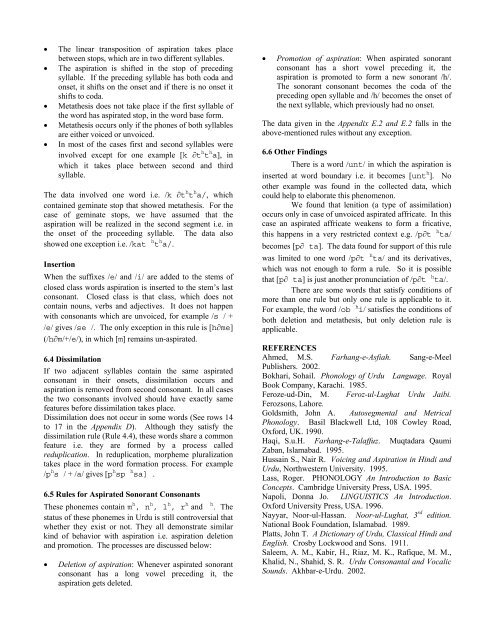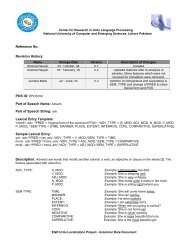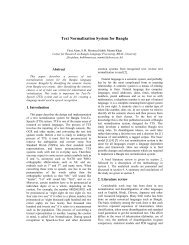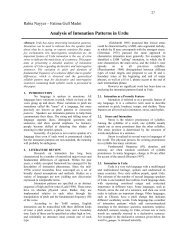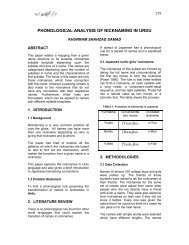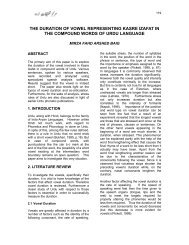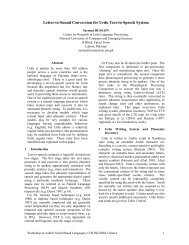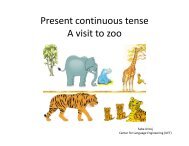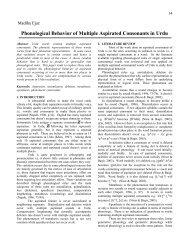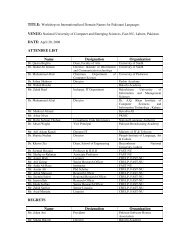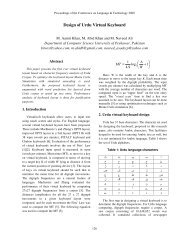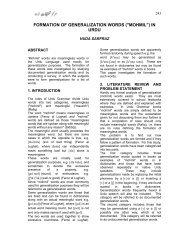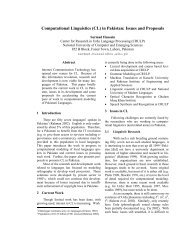Phonological Behavior of Aspirated Consonants in Urdu
Phonological Behavior of Aspirated Consonants in Urdu
Phonological Behavior of Aspirated Consonants in Urdu
You also want an ePaper? Increase the reach of your titles
YUMPU automatically turns print PDFs into web optimized ePapers that Google loves.
• The l<strong>in</strong>ear transposition <strong>of</strong> aspiration takes placebetween stops, which are <strong>in</strong> two different syllables.• The aspiration is shifted <strong>in</strong> the stop <strong>of</strong> preced<strong>in</strong>gsyllable. If the preced<strong>in</strong>g syllable has both coda andonset, it shifts on the onset and if there is no onset itshifts to coda.• Metathesis does not take place if the first syllable <strong>of</strong>the word has aspirated stop, <strong>in</strong> the word base form.• Metathesis occurs only if the phones <strong>of</strong> both syllablesare either voiced or unvoiced.• In most <strong>of</strong> the cases first and second syllables were<strong>in</strong>volved except for one example [k∂t h t h a], <strong>in</strong>which it takes place between second and thirdsyllable.The data <strong>in</strong>volved one word i.e. /k∂t h t h a/, whichconta<strong>in</strong>ed gem<strong>in</strong>ate stop that showed metathesis. For thecase <strong>of</strong> gem<strong>in</strong>ate stops, we have assumed that theaspiration will be realized <strong>in</strong> the second segment i.e. <strong>in</strong>the onset <strong>of</strong> the proceed<strong>in</strong>g syllable. The data alsoshowed one exception i.e. /kat h t h a/.InsertionWhen the suffixes /e/ and /i/ are added to the stems <strong>of</strong>closed class words aspiration is <strong>in</strong>serted to the stem’s lastconsonant. Closed class is that class, which does notconta<strong>in</strong> nouns, verbs and adjectives. It does not happenwith consonants which are unvoiced, for example /s/ +/e/ gives /se/. The only exception <strong>in</strong> this rule is [h∂me](/h∂m/+/e/), <strong>in</strong> which [m] rema<strong>in</strong>s un-aspirated.6.4 DissimilationIf two adjacent syllables conta<strong>in</strong> the same aspiratedconsonant <strong>in</strong> their onsets, dissimilation occurs andaspiration is removed from second consonant. In all casesthe two consonants <strong>in</strong>volved should have exactly samefeatures before dissimilation takes place.Dissimilation does not occur <strong>in</strong> some words (See rows 14to 17 <strong>in</strong> the Appendix D). Although they satisfy thedissimilation rule (Rule 4.4), these words share a commonfeature i.e. they are formed by a process calledreduplication. In reduplication, morpheme pluralizationtakes place <strong>in</strong> the word formation process. For example/p h s/ + /a/ gives [p h sp h sa].6.5 Rules for <strong>Aspirated</strong> Sonorant <strong>Consonants</strong>These phonemes conta<strong>in</strong> m h , n h , l h , r h and h . Thestatus <strong>of</strong> these phonemes <strong>in</strong> <strong>Urdu</strong> is still controversial thatwhether they exist or not. They all demonstrate similark<strong>in</strong>d <strong>of</strong> behavior with aspiration i.e. aspiration deletionand promotion. The processes are discussed below:• Deletion <strong>of</strong> aspiration: Whenever aspirated sonorantconsonant has a long vowel preced<strong>in</strong>g it, theaspiration gets deleted.• Promotion <strong>of</strong> aspiration: When aspirated sonorantconsonant has a short vowel preced<strong>in</strong>g it, theaspiration is promoted to form a new sonorant /h/.The sonorant consonant becomes the coda <strong>of</strong> thepreced<strong>in</strong>g open syllable and /h/ becomes the onset <strong>of</strong>the next syllable, which previously had no onset.The data given <strong>in</strong> the Appendix E.2 and E.2 falls <strong>in</strong> theabove-mentioned rules without any exception.6.6 Other F<strong>in</strong>d<strong>in</strong>gsThere is a word /unt/ <strong>in</strong> which the aspiration is<strong>in</strong>serted at word boundary i.e. it becomes [unt h ]. Noother example was found <strong>in</strong> the collected data, whichcould help to elaborate this phenomenon.We found that lenition (a type <strong>of</strong> assimilation)occurs only <strong>in</strong> case <strong>of</strong> unvoiced aspirated affricate. In thiscase an aspirated affricate weakens to form a fricative,this happens <strong>in</strong> a very restricted context e.g. /p∂t h ta/becomes [p∂ta]. The data found for support <strong>of</strong> this rulewas limited to one word /p∂t h ta/ and its derivatives,which was not enough to form a rule. So it is possiblethat [p∂ta] is just another pronunciation <strong>of</strong> /p∂t h ta/.There are some words that satisfy conditions <strong>of</strong>more than one rule but only one rule is applicable to it.For example, the word /ob h i/ satisfies the conditions <strong>of</strong>both deletion and metathesis, but only deletion rule isapplicable.REFERENCESAhmed, M.S. Farhang-e-Asfiah. Sang-e-MeelPublishers. 2002.Bokhari, Sohail. Phonology <strong>of</strong> <strong>Urdu</strong> Language. RoyalBook Company, Karachi. 1985.Feroze-ud-D<strong>in</strong>, M. Feroz-ul-Lughat <strong>Urdu</strong> Jaibi.Ferozsons, Lahore.Goldsmith, John A. Autosegmental and MetricalPhonology. Basil Blackwell Ltd, 108 Cowley Road,Oxford, UK. 1990.Haqi, S.u.H. Farhang-e-Talaffuz. Muqtadara QaumiZaban, Islamabad. 1995.Hussa<strong>in</strong> S., Nair R. Voic<strong>in</strong>g and Aspiration <strong>in</strong> H<strong>in</strong>di and<strong>Urdu</strong>, Northwestern University. 1995.Lass, Roger. PHONOLOGY An Introduction to BasicConcepts. Cambridge University Press, USA. 1995.Napoli, Donna Jo. LINGUISTICS An Introduction.Oxford University Press, USA. 1996.Nayyar, Noor-ul-Hassan. Noor-ul-Lughat, 3 rd edition.National Book Foundation, Islamabad. 1989.Platts, John T. A Dictionary <strong>of</strong> <strong>Urdu</strong>, Classical H<strong>in</strong>di andEnglish. Crosby Lockwood and Sons. 1911.Saleem, A. M., Kabir, H., Riaz, M. K., Rafique, M. M.,Khalid, N., Shahid, S. R. <strong>Urdu</strong> Consonantal and VocalicSounds. Akhbar-e-<strong>Urdu</strong>. 2002.


